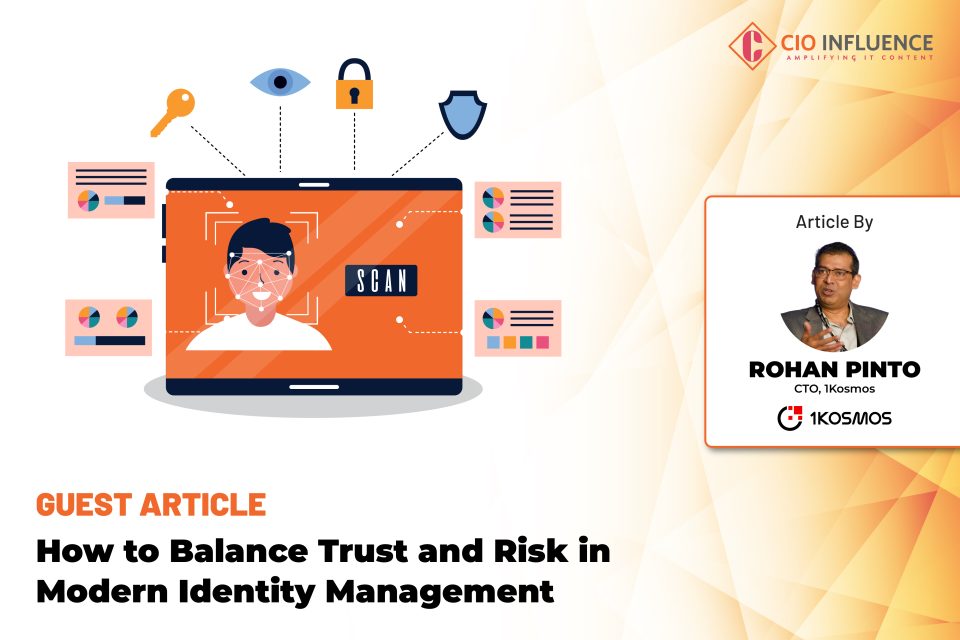Trust and risk, though opposites in meaning, are intrinsically linked in identity management. That’s because digital identities serve as gateways to an organization’s most valuable assets. As identity systems grow more complex, organizations must move beyond conventional measures and adopt advanced strategies to safeguard against evolving threats.
Listen Now: Tech-IT Times by CIOInfluence.com Featuring Todd Cramer, Director Business Development- Security Ecosystem at Intel CCG-Commercial Client Group
Dual Pillars of Identity Management
Trust is the confidence placed in the reliability, security, and ethical behavior of users and systems. It enables secure access to corporate networks, sensitive data, and financial systems. However, trust is always accompanied by risk. The very systems that establish trust can become vectors for risk if not properly managed, leading to compromised identities, data breaches, and financial loss. As digital ecosystems expand, managing identity-based risk has become a top security concern.
Traditional security measures like multi-factor authentication (MFA) and encryption are foundational, but they are not foolproof. Adversaries are increasingly leveraging AI-driven attacks to exploit identity data, conducting large-scale identity theft, phishing, and credential-stuffing attacks at unprecedented speeds. Organizations need to employ AI and machine learning to detect and respond to these anomalies in real time, adapting to threats before they exploit vulnerabilities.
In hybrid and multi-cloud environments, where identities are spread across multiple platforms, centralized control becomes increasingly difficult. CISOs must implement identity governance and administration (IGA) solutions that offer a holistic view of identities, ensuring consistent access controls across all environments. Automating access reviews and remediation processes is crucial to maintaining both compliance and security in these complex settings.
Moreover, the convergence of IT with operational technology (OT) introduces new challenges in identity management. As more devices and systems connect to networks, the attack surface expands, necessitating the integration of identity management into every aspect of digital infrastructure. This requires a shift from reactive to proactive risk management, where continuous monitoring and real-time analytics play a central role.
Also Read: CIO Influence Interview with Neal Quinn, Head of Cloud Security Services, North America at Radware
Biometrics and Identity Verification
As adversaries grow more sophisticated, so must identity verification and authentication methods. Biometrics—such as fingerprint scanning, facial recognition, and iris scanning—offer enhanced security as they are tied to an individual’s unique physical characteristics, making them difficult to replicate or steal. However, biometric data, once compromised, cannot be easily changed like a password, necessitating secure storage and processing using advanced encryption techniques.
The integration of biometrics into identity management is not without its challenges. Privacy concerns, regulatory requirements, and the potential for biometric data breaches must all be addressed. Multi-modal biometrics, which combine several biometric factors (e.g., facial recognition and fingerprint scanning), can enhance security by reducing reliance on any single method.
Beyond authentication, identity verification—confirming that an individual is who they claim to be before granting access—is increasingly important. In environments where access to critical resources is at stake, simply authenticating a user based on credentials is insufficient. Identity verification requires corroborating information from various sources, such as government-issued IDs or third-party databases, to ensure that the user’s identity is genuine. Integrating robust identity verification processes reduces fraud and ensures that only legitimate users gain access to sensitive systems.
Also Read: Future of Endpoint Detection and Response (EDR) in Cybersecurity
Zero Trust Security: A Necessary Shift
For organizations, implementing a zero trust security framework means moving beyond traditional perimeter-based defenses to a model where continuous verification is required across all access points. This identity-centric approach involves ongoing analysis of contextual data—such as user behavior, device posture, and access patterns—to dynamically adjust trust levels and contain threats before they escalate.
Zero trust also addresses the challenge of lateral movement within a network, where an attacker gains access to one system and then moves across the network undetected. By enforcing strict access controls and continuous monitoring, zero trust limits the ability of attackers to exploit vulnerabilities once they are inside the network, significantly enhancing overall security posture.
Real-World Risk Mitigation
Industries are adopting various strategies to effectively mitigate identity-related risks:
- Financial Sector: Leading institutions are implementing decentralized identity models, reducing reliance on centralized identity stores, which are prime targets for attackers. By leveraging blockchain technology, they distribute identity data across secure, decentralized networks, making it harder for attackers to compromise large volumes of data.
- Healthcare: Organizations are adopting identity federation standards to manage patient data securely across providers. This not only ensures compliance with regulations like HIPAA but also enhances security by reducing the need for duplicate identity stores, which can be vulnerable to attack.
- Tech Industry: Companies in Silicon Valley are pioneering continuous authentication, where users are authenticated not just at login but throughout their session using real-time behavioral biometrics. This reduces the risk of session hijacking and insider threats, offering robust security for high-stakes environments.
These examples highlight the need for a multifaceted approach to identity risk management that is tailored to the specific needs and challenges of each industry.
Trust and risk are two sides of the same coin in identity management. The challenge is maintaining this balance as threats grow more advanced and digital ecosystems become more complex. A dynamic approach that integrates advanced risk assessment, proactive identity management strategies, zero trust principles, and robust identity verification techniques represents the best path forward.
[To share your insights with us as part of editorial or sponsored content, please write to psen@itechseries.com]


